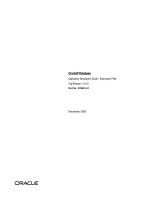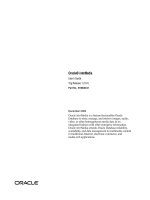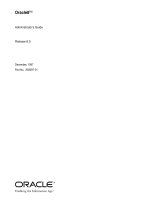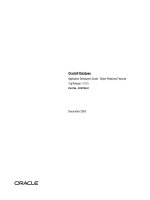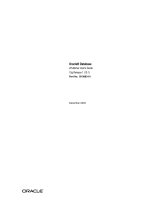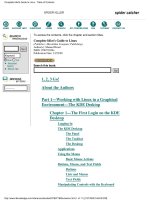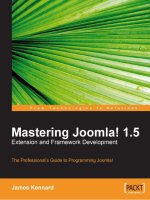Tài liệu Oracle8 Administrator’s Guide pdf
Bạn đang xem bản rút gọn của tài liệu. Xem và tải ngay bản đầy đủ của tài liệu tại đây (2.02 MB, 512 trang )
Oracle8
Administrator’s Guide
Release 8.0
December, 1997
Part No. A58397-01
Oracle8 Administrator’s Guide
Part No. A58397-01
Release 8.0
Copyright © 1997, Oracle Corporation. All rights reserved.
Primary Author: Joyce Fee
Graphic Designer: Valarie Moore
Contributors: John Bellemore, Atif Chaudhry, Sandra Cheevers, Connie Dialeris, John Frazzini, Mike
Hartstein, Bhaskar Himatsingka, Alex Ho, Wei Huang, Ken Jacobs, Robert Jenkins, Val Kane, Andre Krug-
likov, Bill Lee, Nina Lewis, Phil Locke, Diana Lorentz, Ekrem Soylemez, Jags Srinivasan, Ashwini Surpur,
Alex Tsukerman
The programs are not intended for use in any nuclear, aviation, mass transit, medical, or other inher-
ently dangerous applications. It shall be licensee's responsibility to take all appropriate fail-safe, back
up, redundancy and other measures to ensure the safe use of such applications if the Programs are
used for such purposes, and Oracle disclaims liability for any damages caused by such use of the Pro-
grams.
This Program contains proprietary information of Oracle Corporation; it is provided under a license
agreement containing restrictions on use and disclosure and is also protected by copyright patent and
other intellectual property law. Reverse engineering of the software is prohibited.
The information contained in this document is subject to change without notice. If you find any problems
in the documentation, please report them to us in writing. Oracle Corporation does not warrant that this
document is error free.
If this Program is delivered to a U.S. Government Agency of the Department of Defense, then it is deliv-
ered with Restricted Rights and the following legend is applicable:
Restricted Rights Legend Programs delivered subject to the DOD FAR Supplement are 'commercial
computer software' and use, duplication and disclosure of the Programs shall be subject to the licensing
restrictions set forth in the applicable Oracle license agreement. Otherwise, Programs delivered subject to
the Federal Acquisition Regulations are 'restricted computer software' and use, duplication and disclo-
sure of the Programs shall be subject to the restrictions in FAR 52..227-14, Rights in Data -- General,
including Alternate III (June 1987). Oracle Corporation, 500 Oracle Parkway, Redwood City, CA 94065.
Oracle, SQL*Loader, Secure Network Services, and SQL*Plus are registered trademarks of Oracle
Corporation, Redwood Shores, California. Oracle Call Interface, Oracle8, Oracle Parallel Server, Oracle
Forms, Oracle TRACE, Oracle Expert, Oracle Enterprise Manager, Oracle Server Manager, Net8, PL/SQL,
and Pro*C are trademarks of Oracle Corporation, Redwood Shores, California.
All other products or company names are used for identification purposes only, and may be trademarks
of their respective owners.
iii
Contents
Send Us Your Comments
................................................................................................................. xix
Preface
.......................................................................................................................................................... xxi
Part I Basic Database Administration
1 The Oracle Database Administrator
Types of Oracle Users......................................................................................................................... 1-2
Database Administrators............................................................................................................. 1-2
Security Officers............................................................................................................................ 1-3
Application Developers............................................................................................................... 1-3
Application Administrators........................................................................................................ 1-3
Database Users.............................................................................................................................. 1-3
Network Administrators ............................................................................................................. 1-4
Database Administrator Security and Privileges ......................................................................... 1-4
The Database Administrator’s Operating System Account ................................................... 1-4
Database Administrator Usernames.......................................................................................... 1-5
The DBA Role................................................................................................................................ 1-6
Database Administrator Authentication........................................................................................ 1-6
Selecting an Authentication Method ......................................................................................... 1-6
Using Operating System Authentication .................................................................................. 1-7
OSOPER and OSDBA................................................................................................................... 1-8
Using an Authentication Password File.................................................................................... 1-9
Password File Administration.......................................................................................................... 1-9
iv Oracle8 Administrator’s Guide
Using ORAPWD ......................................................................................................................... 1-10
Setting REMOTE_LOGIN_ PASSWORDFILE........................................................................ 1-11
Adding Users to a Password File ............................................................................................. 1-12
Connecting with Administrator Privileges............................................................................. 1-14
Maintaining a Password File..................................................................................................... 1-15
Database Administrator Utilities................................................................................................... 1-17
Enterprise Manager .................................................................................................................... 1-17
SQL*Loader ................................................................................................................................. 1-17
Export and Import ...................................................................................................................... 1-17
Initial Priorities of a Database Administrator............................................................................. 1-18
Step 1: Install the Oracle Software............................................................................................ 1-18
Step 2: Evaluate the Database Server Hardware.................................................................... 1-19
Step 3: Plan the Database........................................................................................................... 1-19
Step 4: Create and Open the Database..................................................................................... 1-20
Step 5: Implement the Database Design.................................................................................. 1-20
Step 6: Back up the Database..................................................................................................... 1-20
Step 7: Enroll System Users....................................................................................................... 1-21
Step 8: Tune Database Performance......................................................................................... 1-21
Identifying Oracle Software Releases .......................................................................................... 1-21
Release Number Format ............................................................................................................ 1-21
Versions of Other Oracle Software........................................................................................... 1-23
Checking Your Current Release Number ............................................................................... 1-23
2 Creating an Oracle Database
Considerations Before Creating a Database.................................................................................. 2-2
Creation Prerequisites.................................................................................................................. 2-3
Using an Initial Database............................................................................................................. 2-3
Migrating an Older Version of the Database............................................................................ 2-3
Creating an Oracle Database ............................................................................................................ 2-4
Steps for Creating an Oracle Database ...................................................................................... 2-4
Creating a Database: Example .................................................................................................... 2-7
Troubleshooting Database Creation .......................................................................................... 2-8
Dropping a Database.................................................................................................................... 2-8
Parameters ............................................................................................................................................ 2-9
DB_NAME and DB_DOMAIN................................................................................................... 2-9
v
CONTROL_FILES....................................................................................................................... 2-10
DB_BLOCK_SIZE ....................................................................................................................... 2-11
DB_BLOCK_BUFFERS............................................................................................................... 2-11
PROCESSES................................................................................................................................. 2-12
ROLLBACK_SEGMENTS ......................................................................................................... 2-12
License Parameters..................................................................................................................... 2-12
LICENSE_MAX_SESSIONS_and LICENSE_SESSIONS WARNING................................. 2-13
LICENSE_MAX_USERS ............................................................................................................ 2-13
Considerations After Creating a Database .................................................................................. 2-14
Initial Tuning Guidelines ............................................................................................................... 2-14
Allocating Rollback Segments .................................................................................................. 2-14
Choosing the Number of DB_BLOCK_LRU_LATCHES...................................................... 2-15
Distributing I/O.......................................................................................................................... 2-16
3 Starting Up and Shutting Down
Startup Procedures.............................................................................................................................. 3-2
Preparing to Start an Instance..................................................................................................... 3-2
Starting an Instance: Scenarios ................................................................................................... 3-3
Altering Database Availability ........................................................................................................ 3-6
Mounting a Database to an Instance.......................................................................................... 3-7
Opening a Closed Database ........................................................................................................ 3-7
Restricting Access to an Open Database ................................................................................... 3-7
Shutdown Procedures........................................................................................................................ 3-8
Shutting Down a Database Under Normal Conditions........................................................ 3-10
Shutting Down a Database Immediately ................................................................................ 3-11
Shutdown Transactional............................................................................................................ 3-11
Aborting an Instance.................................................................................................................. 3-12
Using Parameter Files ...................................................................................................................... 3-12
The Sample Parameter File........................................................................................................ 3-13
The Number of Parameter Files................................................................................................ 3-13
The Location of the Parameter File in Distributed Environments ...................................... 3-13
vi Oracle8 Administrator’s Guide
Part II Oracle Server Configuration
4 Managing Oracle Processes
Configuring Oracle for Dedicated Server Processes .................................................................... 4-2
When to Connect to a Dedicated Server Process ..................................................................... 4-3
Configuring Oracle for Multi-Threaded Server Processes.......................................................... 4-3
SHARED_POOL_ SIZE: Allocating Additional Space in the Shared Pool for
Shared Server 4-5
MTS_LISTENER_ ADDRESS: Setting the Listener Process Address.................................... 4-5
MTS_SERVICE: Specifying Service Names for Dispatchers .................................................. 4-6
MTS_DISPATCHERS: Setting the Initial Number of Dispatchers ........................................ 4-7
MTS_MAX_ DISPATCHERS: Setting the Maximum Number of Dispatchers.................... 4-8
MTS_SERVERS: Setting the Initial Number of Shared Server Processes ............................. 4-9
MTS_MAX_SERVERS: Setting the Maximum Number of Shared
Server Processes............................................................................................................................ 4-9
Modifying Server Processes............................................................................................................ 4-10
Changing the Minimum Number of Shared Server Processes ............................................ 4-10
Adding and Removing Dispatcher Processes ........................................................................ 4-10
Tracking Oracle Processes ............................................................................................................... 4-11
Monitoring the Processes of an Oracle Instance..................................................................... 4-11
Trace Files, the ALERT File, and Background Processes...................................................... 4-14
Starting the Checkpoint Process............................................................................................... 4-16
Managing Processes for the Parallel Query Option................................................................... 4-17
Managing the Query Servers .................................................................................................... 4-17
Variations in the Number of Query Server Processes........................................................... 4-17
Managing Processes for External Procedures.............................................................................. 4-18
Terminating Sessions ....................................................................................................................... 4-20
Identifying Which Session to Terminate ................................................................................. 4-20
Terminating an Active Session ................................................................................................. 4-21
Terminating an Inactive Session............................................................................................... 4-21
5 Managing the Online Redo Log
Planning the Online Redo Log......................................................................................................... 5-2
Multiplex the Online Redo Log .................................................................................................. 5-2
Place Online Redo Log Members on Different Disks.............................................................. 5-3
vii
Set the Size of Online Redo Log Members................................................................................ 5-3
Choose an Appropriate Number of Online Redo Log Files................................................... 5-4
Creating Online Redo Log Groups and Members ....................................................................... 5-5
Creating Online Redo Log Groups ............................................................................................ 5-5
Creating Online Redo Log Members......................................................................................... 5-6
Renaming and Relocating Online Redo Log Members .............................................................. 5-6
Dropping Online Redo Log Groups ............................................................................................... 5-8
Dropping Online Redo Log Members............................................................................................ 5-9
Controlling Checkpoints and Log Switches................................................................................ 5-10
Setting Database Checkpoint Intervals ................................................................................... 5-11
Forcing a Log Switch.................................................................................................................. 5-12
Forcing a Fast Database Checkpoint Without a Log Switch ................................................ 5-13
Verifying Blocks in Redo Log Files............................................................................................... 5-13
Clearing an Online Redo Log File................................................................................................. 5-14
Restrictions .................................................................................................................................. 5-14
Listing Information about the Online Redo Log........................................................................ 5-15
6 Managing Control Files
Guidelines for Control Files............................................................................................................. 6-2
Name Control Files....................................................................................................................... 6-2
Multiplex Control Files on Different Disks............................................................................... 6-2
Place Control Files Appropriately.............................................................................................. 6-3
Manage the Size of Control Files................................................................................................ 6-3
Creating Control Files........................................................................................................................ 6-3
Creating Initial Control Files....................................................................................................... 6-4
Creating Additional Copies of the Control File, and Renaming and
Relocating Control Files.............................................................................................................. 6-4
New Control Files......................................................................................................................... 6-5
Creating New Control Files ........................................................................................................ 6-6
Troubleshooting After Creating Control Files .............................................................................. 6-8
Checking for Missing or Extra Files........................................................................................... 6-8
Handling Errors During CREATE CONTROLFILE................................................................ 6-9
Dropping Control Files...................................................................................................................... 6-9
viii Oracle8 Administrator’s Guide
7 Managing Job Queues
SNP Background Processes............................................................................................................... 7-2
Multiple SNP processes ............................................................................................................... 7-3
Starting up SNP processes........................................................................................................... 7-3
Managing Job Queues........................................................................................................................ 7-4
DBMS_JOB Package ..................................................................................................................... 7-4
Submitting a Job to the Job Queue ............................................................................................. 7-6
How Jobs Execute ....................................................................................................................... 7-10
Removing a Job From the Job Queue....................................................................................... 7-12
Altering a Job............................................................................................................................... 7-12
Broken Jobs .................................................................................................................................. 7-14
Forcing a Job to Execute............................................................................................................. 7-15
Terminating a Job........................................................................................................................ 7-16
Viewing Job Queue Information ................................................................................................... 7-16
Part III Oracle Server Configuration
8 Managing Tablespaces
Guidelines for Managing Tablespaces ........................................................................................... 8-2
Using Multiple Tablespaces ........................................................................................................ 8-2
Specifying Tablespace Storage Parameters............................................................................... 8-3
Assigning Tablespace Quotas to Users...................................................................................... 8-3
Creating Tablespaces.......................................................................................................................... 8-3
Creating a Temporary Tablespace.............................................................................................. 8-5
Managing Tablespace Allocation..................................................................................................... 8-6
Altering Storage Settings for Tablespaces................................................................................. 8-6
Coalescing Free Space .................................................................................................................. 8-6
Altering Tablespace Availability ..................................................................................................... 8-8
Bringing Tablespaces Online....................................................................................................... 8-8
Taking Tablespaces Offline ......................................................................................................... 8-9
Making a Tablespace Read-Only ................................................................................................... 8-11
Prerequisites ................................................................................................................................ 8-12
Making a Read-Only Tablespace Writeable............................................................................ 8-13
Creating a Read-Only Tablespace on a WORM Device........................................................ 8-13
ix
Dropping Tablespaces...................................................................................................................... 8-14
Viewing Information About Tablespaces .................................................................................... 8-15
9 Managing Datafiles
Guidelines for Managing Datafiles................................................................................................. 9-2
Number of Datafiles..................................................................................................................... 9-2
Set the Size of Datafiles................................................................................................................ 9-4
Place Datafiles Appropriately..................................................................................................... 9-4
Store Datafiles Separately From Redo Log Files...................................................................... 9-4
Creating and Adding Datafiles to a Tablespace............................................................................ 9-5
Changing a Datafile’s Size ................................................................................................................ 9-5
Enabling and Disabling Automatic Extension for a Datafile ................................................. 9-5
Manually Resizing a Datafile...................................................................................................... 9-6
Altering Datafile Availability........................................................................................................... 9-7
Bringing Datafiles Online in ARCHIVELOG Mode................................................................ 9-8
Taking Datafiles Offline in NOARCHIVELOG Mode ............................................................ 9-8
Renaming and Relocating Datafiles................................................................................................ 9-8
Renaming and Relocating Datafiles for a Single Tablespace ................................................. 9-9
Renaming and Relocating Datafiles for Multiple Tablespaces ............................................ 9-10
Verifying Data Blocks in Datafiles ................................................................................................ 9-12
Viewing Information About Datafiles.......................................................................................... 9-13
10 Guidelines for Managing Schema Objects
Managing Space in Data Blocks .................................................................................................... 10-2
The PCTFREE Parameter........................................................................................................... 10-2
The PCTUSED Parameter.......................................................................................................... 10-4
Selecting Associated PCTUSED and PCTFREE Values ........................................................ 10-6
Setting Storage Parameters ............................................................................................................. 10-7
Storage Parameters You Can Specify....................................................................................... 10-7
Setting INITRANS and MAXTRANS ...................................................................................... 10-9
Setting Default Storage Parameters for Segments in a Tablespace ................................... 10-10
Setting Storage Parameters for Data Segments.................................................................... 10-10
Setting Storage Parameters for Index Segments .................................................................. 10-10
Setting Storage Parameters for LOB Segments .................................................................... 10-11
x Oracle8 Administrator’s Guide
Changing Values for Storage Parameters ............................................................................. 10-11
Understanding Precedence in Storage Parameters.............................................................. 10-11
Deallocating Space.......................................................................................................................... 10-13
Viewing the High Water Mark ............................................................................................... 10-13
Issuing Space Deallocation Statements.................................................................................. 10-13
Understanding Space Use of Datatypes ..................................................................................... 10-17
Summary of Oracle Datatypes................................................................................................ 10-20
11 Managing Partitioned Tables and Indexes
What Are Partitioned Tables and Indexes?.................................................................................. 11-2
Creating Partitions............................................................................................................................ 11-2
Maintaining Partitions..................................................................................................................... 11-3
Moving Partitions ....................................................................................................................... 11-4
Adding Partitions ....................................................................................................................... 11-5
Dropping Partitions.................................................................................................................... 11-6
Truncating Partitions.................................................................................................................. 11-8
Splitting Partitions.................................................................................................................... 11-10
Merging Partitions.................................................................................................................... 11-12
Exchanging Table Partitions.................................................................................................... 11-13
Rebuilding Index Partitions .................................................................................................... 11-16
Moving the Time Window in a Historical Table.................................................................. 11-16
Quiescing Applications During a Multi-Step Maintenance Operation ............................ 11-17
12 Managing Tables
Guidelines for Managing Tables ................................................................................................... 12-2
Design Tables Before Creating Them ...................................................................................... 12-2
Specify How Data Block Space Is to Be Used ......................................................................... 12-3
Specify Transaction Entry Parameters..................................................................................... 12-3
Specify the Location of Each Table........................................................................................... 12-3
Parallelize Table Creation.......................................................................................................... 12-4
Consider Creating UNRECOVERABLE Tables ..................................................................... 12-4
Estimate Table Size and Set Storage Parameters.................................................................... 12-5
Plan for Large Tables.................................................................................................................. 12-5
Table Restrictions........................................................................................................................ 12-6
Creating Tables.................................................................................................................................. 12-6
xi
Altering Tables .................................................................................................................................. 12-7
Manually Allocating Storage for a Table ..................................................................................... 12-9
Dropping Tables................................................................................................................................ 12-9
Index-Organized Tables ................................................................................................................ 12-10
What Are Index-Organized Tables? ...................................................................................... 12-10
Creating Index-Organized Tables.......................................................................................... 12-13
Maintaining Index-Organized Tables.................................................................................... 12-16
Scenario: Using the ORDER BY Clause with Index-Organized Tables............................ 12-17
Scenario: Updating the Key Column..................................................................................... 12-17
Converting Index-Organized Tables to Regular Tables ..................................................... 12-18
13 Managing Views, Sequences and Synonyms
Managing Views ............................................................................................................................... 13-2
Creating Views............................................................................................................................ 13-2
Modifying a Join View............................................................................................................... 13-4
Replacing Views ......................................................................................................................... 13-9
Dropping Views........................................................................................................................ 13-10
Managing Sequences ..................................................................................................................... 13-10
Creating Sequences .................................................................................................................. 13-10
Altering Sequences................................................................................................................... 13-11
Initialization Parameters Affecting Sequences..................................................................... 13-11
Dropping Sequences ................................................................................................................ 13-12
Managing Synonyms ..................................................................................................................... 13-12
Creating Synonyms .................................................................................................................. 13-12
Dropping Synonyms ................................................................................................................ 13-13
14 Managing Indexes
Guidelines for Managing Indexes................................................................................................. 14-2
Create Indexes After Inserting Table Data.............................................................................. 14-3
Limit the Number of Indexes per Table .................................................................................. 14-3
Specify Transaction Entry Parameters..................................................................................... 14-4
Specify Index Block Space Use ................................................................................................. 14-4
Specify the Tablespace for Each Index .................................................................................... 14-4
Parallelize Index Creation ......................................................................................................... 14-5
xii Oracle8 Administrator’s Guide
Consider Creating UNRECOVERABLE Indexes ................................................................... 14-5
Estimate Index Size and Set Storage Parameters ................................................................... 14-5
Considerations Before Disabling or Dropping Constraints ................................................. 14-6
Creating Indexes................................................................................................................................ 14-7
Creating an Index Associated with a Constraint ................................................................... 14-7
Creating an Index Explicitly...................................................................................................... 14-8
Re-creating an Existing Index ................................................................................................... 14-8
Altering Indexes................................................................................................................................ 14-9
Monitoring Space Use of Indexes.................................................................................................. 14-9
Dropping Indexes ........................................................................................................................... 14-10
15 Managing Clusters
Guidelines for Managing Clusters................................................................................................ 15-2
Cluster Appropriate Tables....................................................................................................... 15-4
Choose Appropriate Columns for the Cluster Key ............................................................... 15-4
Specify Data Block Space Use ................................................................................................... 15-5
Specify the Space Required by an Average Cluster Key and Its Associated Rows .......... 15-5
Specify the Location of Each Cluster and Cluster Index Rows............................................ 15-5
Estimate Cluster Size and Set Storage Parameters................................................................. 15-6
Creating Clusters............................................................................................................................... 15-6
Creating Clustered Tables ......................................................................................................... 15-7
Creating Cluster Indexes ........................................................................................................... 15-8
Altering Clusters............................................................................................................................... 15-8
Altering Cluster Tables and Cluster Indexes.......................................................................... 15-9
Dropping Clusters .......................................................................................................................... 15-10
Dropping Clustered Tables ..................................................................................................... 15-10
Dropping Cluster Indexes ....................................................................................................... 15-11
16 Managing Hash Clusters
Guidelines for Managing Hash Clusters ..................................................................................... 16-2
Advantages of Hashing ............................................................................................................. 16-2
Disadvantages of Hashing......................................................................................................... 16-3
Estimate Size Required by Hash Clusters and Set Storage Parameters.............................. 16-4
Creating Hash Clusters.............................................................................................................. 16-5
Controlling Space Use Within a Hash Cluster ....................................................................... 16-5
xiii
Altering Hash Clusters .................................................................................................................. 16-10
Dropping Hash Clusters................................................................................................................ 16-10
17 General Management of Schema Objects
Creating Multiple Tables and Views in A Single Operation................................................... 17-2
Renaming Schema Objects ............................................................................................................. 17-2
Analyzing Tables, Indexes, and Clusters ..................................................................................... 17-3
Using Statistics for Tables, Indexes, and Clusters ................................................................. 17-4
Validating Tables, Indexes, and Clusters................................................................................ 17-9
Listing Chained Rows of Tables and Clusters........................................................................ 17-9
Truncating Tables and Clusters.................................................................................................... 17-10
Enabling and Disabling Triggers................................................................................................. 17-12
Enabling Triggers ..................................................................................................................... 17-13
Disabling Triggers .................................................................................................................... 17-13
Managing Integrity Constraints................................................................................................... 17-14
Integrity Constraint States....................................................................................................... 17-14
Deferring Constraint Checks .................................................................................................. 17-17
Managing Constraints That Have Associated Indexes....................................................... 17-19
Disabling, Enable Novalidating and Enabling Integrity Constraints
Upon Definition ........................................................................................................................ 17-19
Enabling and Disabling Existing Integrity Constraints ...................................................... 17-21
Dropping Integrity Constraints.............................................................................................. 17-23
Reporting Constraint Exceptions ........................................................................................... 17-23
Managing Object Dependencies ................................................................................................. 17-25
Manually Recompiling Views ................................................................................................ 17-27
Manually Recompiling Procedures and Functions ............................................................. 17-27
Manually Recompiling Packages ........................................................................................... 17-27
Managing Object Name Resolution............................................................................................ 17-28
Changing Storage Parameters for the Data Dictionary........................................................... 17-29
Structures in the Data Dictionary........................................................................................... 17-29
Errors that Require Changing Data Dictionary Storage ..................................................... 17-31
Displaying Information About Schema Objects...................................................................... 17-32
Dictionary Storage Oracle Packages ...................................................................................... 17-33
Example 1: Displaying Schema Objects By Type................................................................. 17-34
Example 2: Displaying Column Information ....................................................................... 17-34
xiv Oracle8 Administrator’s Guide
Example 3: Displaying Dependencies of Views and Synonyms........................................ 17-35
Example 4: Displaying General Segment Information........................................................ 17-35
Example 5: Displaying General Extent Information............................................................ 17-35
Example 6: Displaying the Free Space (Extents) of a Database ......................................... 17-36
Example 7: Displaying Segments that Cannot Allocate Additional Extents ................... 17-36
Part IV Database Security
18 Managing Rollback Segments
Guidelines for Managing Rollback Segments............................................................................ 18-2
Use Multiple Rollback Segments.............................................................................................. 18-2
Choose Between Public and Private Rollback Segments...................................................... 18-3
Specify Rollback Segments to Acquire Automatically.......................................................... 18-3
Set Rollback Segment Sizes Appropriately............................................................................. 18-4
Create Rollback Segments with Many Equally Sized Extents.............................................. 18-5
Set an Optimal Number of Extents for Each Rollback Segment.......................................... 18-6
Set the Storage Location for Rollback ...................................................................................... 18-7
Creating Rollback Segments........................................................................................................... 18-8
Bringing New Rollback Segments Online............................................................................... 18-8
Specifying Storage Parameters for Rollback Segments ............................................................ 18-8
Setting Storage Parameters When Creating a Rollback Segment........................................ 18-9
Changing Rollback Segment Storage Parameters.................................................................. 18-9
Altering Rollback Segment Format........................................................................................ 18-10
Shrinking a Rollback Segment Manually.............................................................................. 18-10
Taking Rollback Segments Online and Offline........................................................................ 18-11
Bringing Rollback Segments Online ...................................................................................... 18-11
Taking Rollback Segments Offline ......................................................................................... 18-12
Explicitly Assigning a Transaction to a Rollback Segment .................................................... 18-13
Dropping Rollback Segments ...................................................................................................... 18-14
Monitoring Rollback Segment Information.............................................................................. 18-15
Displaying Rollback Segment Information........................................................................... 18-15
xv
19 Establishing Security Policies
System Security Policy..................................................................................................................... 19-2
Database User Management ..................................................................................................... 19-2
User Authentication ................................................................................................................... 19-2
Operating System Security........................................................................................................ 19-3
Data Security Policy ......................................................................................................................... 19-3
User Security Policy ......................................................................................................................... 19-4
General User Security ................................................................................................................ 19-4
End-User Security....................................................................................................................... 19-5
Administrator Security .............................................................................................................. 19-7
Application Developer Security ............................................................................................... 19-9
Application Administrator Security ...................................................................................... 19-11
Password Management Policy ..................................................................................................... 19-12
Account Locking....................................................................................................................... 19-12
Password Aging and Expiration ............................................................................................ 19-13
Password History ..................................................................................................................... 19-14
Password Complexity Verification ........................................................................................ 19-14
Auditing Policy ............................................................................................................................... 19-18
20 Managing Users and Resources
Session and User Licensing ............................................................................................................ 20-2
Concurrent Usage Licensing..................................................................................................... 20-2
Connecting Privileges ................................................................................................................ 20-3
Setting the Maximum Number of Sessions ............................................................................ 20-4
Setting the Session Warning Limit........................................................................................... 20-4
Changing Concurrent Usage Limits While the Database is Running................................. 20-5
Named User Limits .................................................................................................................... 20-5
Viewing Licensing Limits and Current Values...................................................................... 20-7
User Authentication ......................................................................................................................... 20-7
Database Authentication ........................................................................................................... 20-8
External Authentication............................................................................................................. 20-9
Enterprise Authentication ....................................................................................................... 20-11
Oracle Users ..................................................................................................................................... 20-12
xvi Oracle8 Administrator’s Guide
Creating Users........................................................................................................................... 20-12
Altering Users............................................................................................................................ 20-16
Dropping Users......................................................................................................................... 20-17
Managing Resources with Profiles .............................................................................................. 20-18
Creating Profiles ....................................................................................................................... 20-19
Assigning Profiles..................................................................................................................... 20-19
Altering Profiles........................................................................................................................ 20-20
Using Composite Limits .......................................................................................................... 20-20
Dropping Profiles ..................................................................................................................... 20-22
Enabling and Disabling Resource Limits .............................................................................. 20-22
Listing Information About Database Users and Profiles........................................................ 20-23
Listing Information about Users and Profiles: Examples ................................................... 20-24
Examples........................................................................................................................................... 20-27
21 Managing User Privileges and Roles
Identifying User Privileges............................................................................................................. 21-2
System Privileges........................................................................................................................ 21-2
Object Privileges.......................................................................................................................... 21-9
Managing User Roles ..................................................................................................................... 21-11
Creating a Role.......................................................................................................................... 21-11
Predefined Roles ....................................................................................................................... 21-12
Role Authorization ................................................................................................................... 21-13
Dropping Roles ......................................................................................................................... 21-15
Granting User Privileges and Roles............................................................................................ 21-16
Granting System Privileges and Roles................................................................................... 21-16
Granting Object Privileges and Roles .................................................................................... 21-17
Granting Privileges on Columns ............................................................................................ 21-18
Revoking User Privileges and Roles........................................................................................... 21-19
Revoking System Privileges and Roles.................................................................................. 21-19
Revoking Object Privileges and Roles ................................................................................... 21-19
Effects of Revoking Privileges................................................................................................. 21-21
Granting to and Revoking from the User Group PUBLIC ................................................. 21-22
Granting Roles Using the Operating System or Network...................................................... 21-23
Using Operating System Role Identification ........................................................................ 21-24
Using Operating System Role Management......................................................................... 21-25
xvii
Granting and Revoking Roles When OS_ROLES=TRUE................................................... 21-25
Enabling and Disabling Roles When OS_ROLES=TRUE................................................... 21-26
Using Network Connections with Operating System Role Management ....................... 21-26
Listing Privilege and Role Information ..................................................................................... 21-26
Listing Privilege and Role Information: Examples.............................................................. 21-27
22 Auditing Database Use
Guidelines for Auditing.................................................................................................................. 22-2
Audit via the Database or Operating System......................................................................... 22-2
Keep Audited Information Manageable ................................................................................. 22-2
Creating and Deleting the Database Audit Trail Views............................................................ 22-4
Creating the Audit Trail Views ................................................................................................ 22-4
Deleting the Audit Trail Views................................................................................................. 22-5
Managing Audit Trail Information ............................................................................................... 22-5
Events Audited by Default........................................................................................................ 22-7
Setting Auditing Options .......................................................................................................... 22-7
Enabling and Disabling Database Auditing......................................................................... 22-13
Controlling the Growth and Size of the Audit Trail ........................................................... 22-14
Protecting the Audit Trail........................................................................................................ 22-17
Viewing Database Audit Trail Information............................................................................... 22-17
Listing Active Statement Audit Options............................................................................... 22-19
Listing Active Privilege Audit Options................................................................................. 22-19
Listing Active Object Audit Options for Specific Objects................................................... 22-19
Listing Default Object Audit Options.................................................................................... 22-20
Listing Audit Records.............................................................................................................. 22-20
Listing Audit Records for the AUDIT SESSION Option .................................................... 22-20
Auditing Through Database Triggers......................................................................................... 22-21
23 Archiving Redo Information
Choosing Between NOARCHIVELOG and ARCHIVELOG Mode....................................... 23-2
Running a Database in NOARCHIVELOG Mode................................................................. 23-2
Running a Database in ARCHIVELOG Mode ....................................................................... 23-2
Turning Archiving On and Off ...................................................................................................... 23-4
Setting the Initial Database Archiving Mode ......................................................................... 23-4
xviii Oracle8 Administrator’s Guide
Changing the Database Archiving Mode................................................................................ 23-5
Enabling Automatic Archiving................................................................................................. 23-6
Disabling Automatic Archiving................................................................................................ 23-7
Performing Manual Archiving ................................................................................................. 23-8
Tuning Archiving.............................................................................................................................. 23-9
Minimizing the Impact on System Performance.................................................................... 23-9
Improving Archiving Speed.................................................................................................... 23-10
Displaying Archiving Status Information................................................................................. 23-10
Specifying the Archived Redo Log Filename Format and Destination ............................... 23-12
A Space Estimations for Schema Objects
Estimating Space Required by Non-Clustered Tables ................................................................ A-2
Estimating Space for Indexes............................................................................................................ A-5
Estimating Space Required by Clusters ...................................................................................... A-10
Estimating Space Required by Hash Clusters............................................................................ A-16
Index
xix
Send Us Your Comments
Oracle8 Administrator’s Guide, 8.0
Part No. A58397-01
Oracle Corporation welcomes your comments and suggestions on the quality and usefulness of this
publication. Your input is an important part of the information used for revision.
■
Did you find any errors?
■
Is the information clearly presented?
■
Do you need more information? If so, where?
■
Are the examples correct? Do you need more examples?
■
What features did you like most about this manual?
If you find any errors or have any other suggestions for improvement, please indicate the chapter,
section, and page number (if available). You can send comments to us in the following ways:
■
email:
■
fax: (650) 506-7228 Attn: Server Technologies Documentation Manager
■
letter: Server Technologies Documentation Manager
Oracle Corporation
500 Oracle Parkway
Redwood Shores, CA 94065
If you would like a reply, please give your name, address, and telephone number below.
xx
xxi
Preface
This guide is for people who administer the operation of an Oracle database sys-
tem. These people, referred to as “database administrators” (DBAs), are assumed to
be responsible for ensuring the smooth operation of an Oracle database system and
for monitoring its use. The responsibilities of database administrators are described
in Chapter 1.
Attention:
The Oracle8 Administrator’s Guide contains information
that describes the features and functionality of the Oracle8 and the
Oracle8 Enterprise Edition products. Oracle8 and Oracle8 Enter-
prise Edition have the same basic features. However, several
advanced features are available only with the Enterprise Edition,
and some of these are optional. For example, to perform auto-
mated tablespace point-in-time recovery (using Recovery Man-
ager), you must have the Enterprise Edition.
For information about the differences between Oracle8 and the
Oracle8 Enterprise Edition and the features and options that are
available to you, please refer to Getting to Know Oracle8 and the
Oracle8 Enterprise Edition
xxii
Audience
Readers of this guide are assumed to be familiar with relational database concepts.
They are also assumed to be familiar with the operating system environment under
which they are running Oracle.
As a prerequisite, all readers should read the first chapter of Oracle8 Concepts, “A
Technical Introduction to the Oracle Server.” This chapter is a comprehensive intro-
duction to the concepts and terminology used throughout this guide.
Readers Interested in Installation and Migration Information
Administrators frequently participate in installing the Oracle Server software and
migrating existing Oracle databases to newer formats (for example, Version 7 data-
bases to Oracle8 format). This guide is not an installation or migration manual.
If your primary interest is installation, see your operating system-specific Oracle
documentation.
If your primary interest is database or application migration, see the Oracle8 Migra-
tion manual.
Readers Interested in Application Design Information
In addition to administrators, experienced users of Oracle and advanced database
application designers might also find information in this guide useful.
However, database application developers should also see the Oracle8 Application
Developer’s Guide and the documentation for the tool or language product they are
using to develop Oracle database applications.
How to Use This Guide
Every reader of this guide should read Chapter 1 of the Oracle8 Concepts manual,
“Introduction to the Oracle Server.” This overview of the concepts and terminology
related to Oracle provides a foundation for the more detailed information in this
guide. The rest of the Oracle8 Concepts manual explains the Oracle architecture and
features, and how they operate in more detail.
xxiii
Structure
This guide contains the following parts and chapters.
Part I: Basic Database Administration
Part II: Oracle Server Configuration
Chapter 1, “The Oracle Database
Administrator”
This chapter serves as a general introduction
to typical tasks performed by database
administrators, such as installing software
and planning a database.
Chapter 2, “Creating an Oracle
Database”
This chapter describes the most important
considerations when creating a database.
Consult this chapter when in the database
planning stage.
Chapter 3, “Starting Up and Shut-
ting Down”
Consult this chapter when you wish to start
up a database, alter its availability, or shut it
down. Parameter files related to starting up
and shutting down are also described here.
Chapter 4, “Managing Oracle Pro-
cesses”
This chapter helps you identify different Ora-
cle processes, such as dedicated server pro-
cesses and multi-threaded server processes.
Consult this chapter when configuring, modi-
fying, tracking and managing processes.
Chapter 5, “Managing the Online
Redo Log”
This chapter describes all aspects of manag-
ing the online redo log (such as planning, cre-
ating, renaming, dropping or clearing online
redo log files).
Chapter 6, “Managing Control
Files”
This chapter describes all aspects of manag-
ing control files (such as naming, creating,
troubleshooting and dropping control files).
Chapter 7, “Managing Job
Queues”
Consult this chapter before working with job
queues. All aspects of submitting, removing,
altering and fixing job queues are described.
xxiv
Part III: Database Storage
Chapter 8, “Managing Tablespaces” This chapter provides guidelines to fol-
low as you manage tablespaces, and
describes how to create, manage, alter
and drop tablespaces.
Chapter 9, “Managing Datafiles” This chapter provides guidelines to fol-
low as you manage datafiles, and
describes how to create, change, alter,
rename and view information about data-
files.
Chapter 10, “Guidelines for Managing
Schema Objects”
Consult this chapter for descriptions of
common tasks, such as setting storage
parameters, deallocating space and man-
aging space.
Chapter 11, “Managing Partitioned
Tables and Indexes”
This chapter describes what a partitioned
table (and index) is and how to create
and manage it.
Chapter 12, “Managing Tables” Consult this chapter for general table
management guidelines, as well as infor-
mation about creating, altering, maintain-
ing and dropping tables.
Chapter 13, “Managing Views,
Sequences and Synonyms”
This chapter describes all aspects of man-
aging views, sequences and synonyms.
Chapter 14, “Managing Indexes” Consult this chapter for general guide-
lines about indexes, including creating,
altering, monitoring and dropping
indexes.
Chapter 15, “Managing Clusters” Consult this chapter for general guide-
lines to follow when creating, altering
and dropping clusters.
Chapter 16, “Managing Hash Clusters” Consult this chapter for general guide-
lines to follow when altering or dropping
hash clusters.
xxv
Part IV: Database Security
Chapter 17, “General Management of
Schema Objects”
This chapter covers more specific aspects
of schema management than those identi-
fied in Chapter 10. Consult this chapter
for information about table analysis, trun-
cation of tables and clusters, database
triggers, integrity constraints, object
dependencies. You will also find a num-
ber of specific examples.
Chapter 18, “Managing Rollback Seg-
ments”
Consult this chapter for guidelines to fol-
low when working with rollback seg-
ments.
Chapter 19, “Establishing Security Pol-
icies”
This chapter describes all aspects of data-
base security, including system, data and
user security policies, as well as specific
tasks associated with password manage-
ment.
Chapter 20, “Managing Users and
Resources”
This chapter describes session and user
licensing, user authentication, and pro-
vides specific examples of tasks associ-
ated with managing users and resources.
Chapter 21, “Managing User Privi-
leges and Roles”
This chapter contains information about
all aspects of managing user privileges
and roles. Consult this chapter to find
out how to grant and revoke privileges
and roles.
Chapter 22, “Auditing Database Use” This chapter describes how to create,
manage and view audit information.
Chapter 23, “Archiving Redo Informa-
tion”
Consult this chapter for information
about archive modes, tuning archiving,
and viewing
